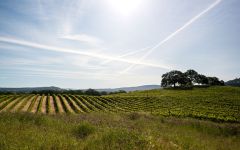Hall Napa Valley Sauvignon Blanc 2023
-
Wine
Enthusiast -
James
Suckling



Product Details
Your Rating
Somm Note
Winemaker Notes
Professional Ratings
-
Wine Enthusiast
Pithy aromatics mesh with flavors of sweet melon, ripe apple, nectarine and a squeeze of apricot. The firm acidity of this wine enlivens the palate, lingering through pleasing grapefruit.
-
James Suckling
The nose gives soft aromas of lemon pith, grapefruit and kaffir limes. The palate is medium-bodied with vibrant acidity, offering notes of orange sherbet, cut grass and fresh pineapple. Simple and fresh.
Other Vintages
2019-
Wine
Spectator -
Jeb
Dunnuck
-
Wilfred
Wong -
Wine
Enthusiast
-
Wilfred
Wong
-
Wine
Spectator
-
Wine
Enthusiast -
Wilfred
Wong -
Wine
Spectator
-
Wine
Enthusiast
-
Wine
Spectator
-
Wine
Enthusiast
-
Wine &
Spirits -
Wine
Enthusiast
-
Wine
Spectator
-
Wine
Enthusiast
-
Wine
Enthusiast








Hall Wines is located in Napa Valley and employs organic small-vine viticulture, precision winemaking, wild-yeast fermentation and micro-block blending to fully extract the purity and quintessence of Napa Valley Cabernet Sauvignon. Their estate vineyards encompass more than 300 acres of classic Bordeaux varietals: Cabernet Sauvignon, Merlot and Sauvignon Blanc. The Halls have a strong respect for the environment and a commitment to cutting edge technology to yield the highest quality grapes. Through meticulous attention to detail in the vineyards, Hall wines are able to express the unique and diverse character of Napa Valley's soils and climate.

Capable of a vast array of styles, Sauvignon Blanc is a crisp, refreshing variety that equally reflects both terroir and varietal character. Though it can vary depending on where it is grown, a couple of commonalities always exist—namely, zesty acidity and intense aromatics. This variety is of French provenance. Somm Secret—Along with Cabernet Franc, Sauvignon Blanc is a proud parent of Cabernet Sauvignon. That green bell pepper aroma that all three varieties share is no coincidence—it comes from a high concentration of pyrazines (herbaceous aromatic compounds) inherent to each member of the family.

One of the world's most highly regarded regions for wine production as well as tourism, the Napa Valley was responsible for bringing worldwide recognition to California winemaking. In the 1960s, a few key wine families settled the area and hedged their bets on the valley's world-class winemaking potential—and they were right.
The Napa wine industry really took off in the 1980s, when producers scooped up vineyard lands and planted vines throughout the county. A number of wineries emerged, and today Napa is home to hundreds of producers ranging from boutique to corporate. Cabernet Sauvignon is definitely the grape of choice here, with many winemakers also focusing on Bordeaux blends. White wines from Napa Valley are usually Chardonnay and Sauvignon Blanc.
Within the Napa Valley lie many smaller sub-AVAs that claim specific wine characteristics based on situation, slope and soil. Farthest south and coolest from the influence of the San Pablo Bay is Carneros, followed by Coombsville to its northeast and then Yountville, Oakville and Rutherford. Above those are the warm St. Helena and the valley's newest and hottest AVA, Calistoga. These areas follow the valley floor and are known generally for creating rich, dense, complex and smooth red wines with good aging potential. The mountain sub appellations, nestled on the slopes overlooking the valley AVAs, include Stags Leap District, Atlas Peak, Chiles Valley (farther east), Howell Mountain, Mt. Veeder, Spring Mountain District and Diamond Mountain District. Napa Valley wines from the mountain regions are often more structured and firm, benefiting from a lot of time in the bottle to evolve and soften.
